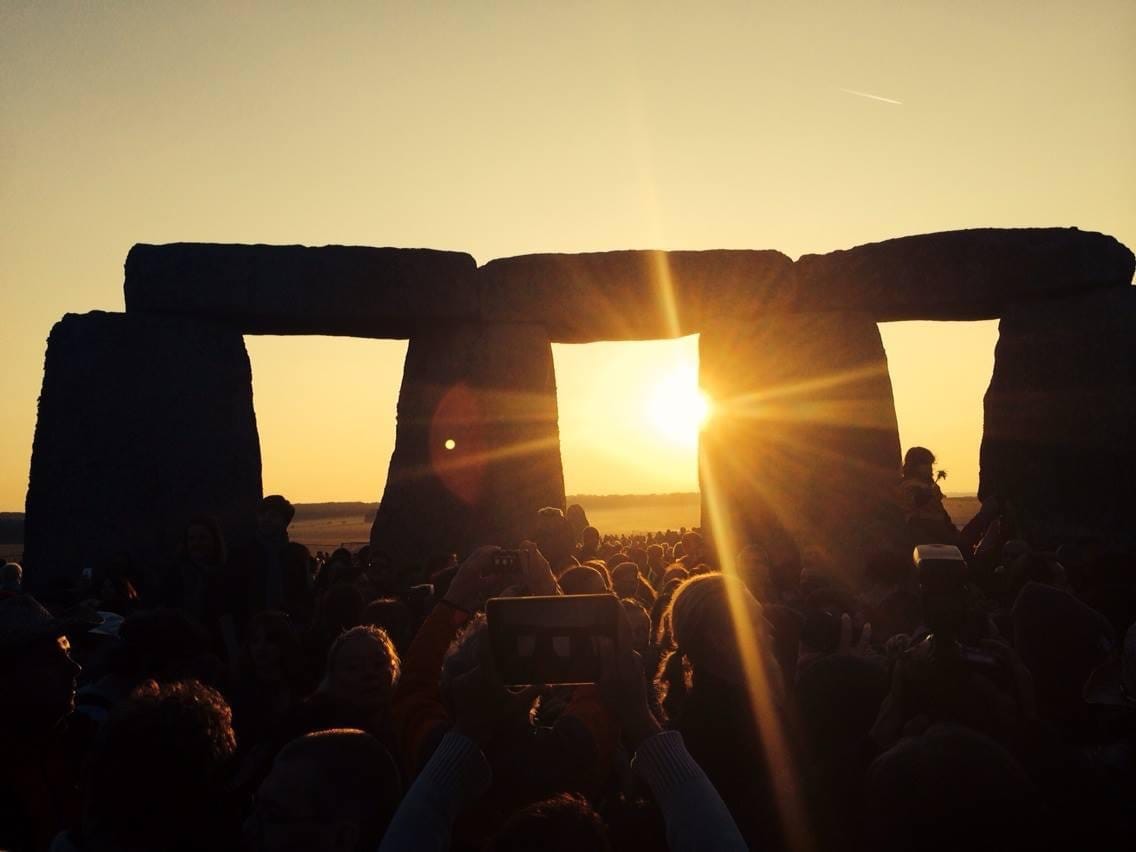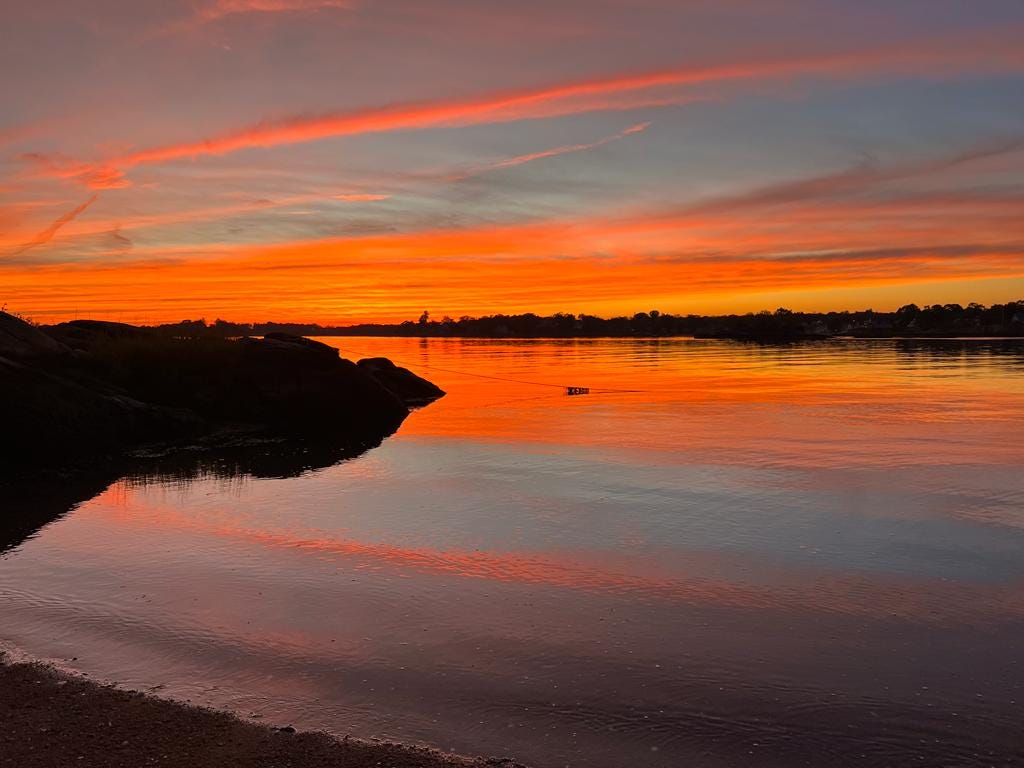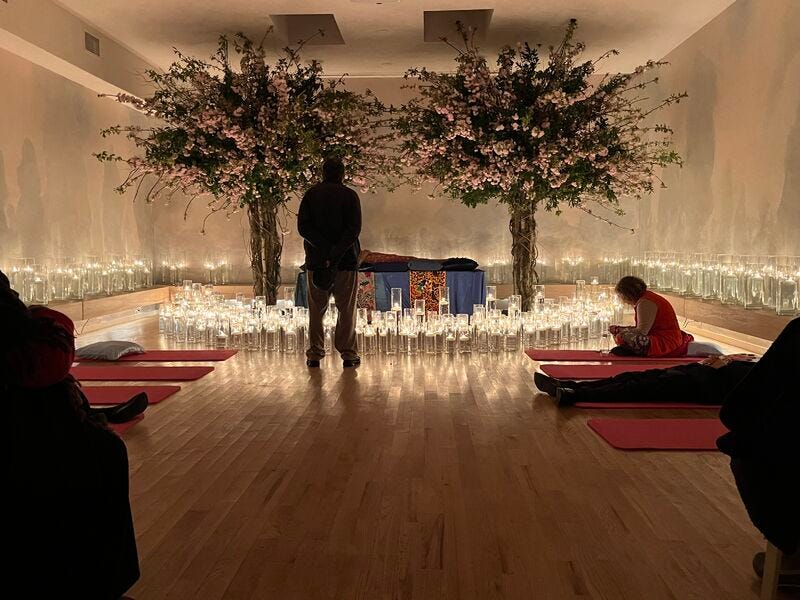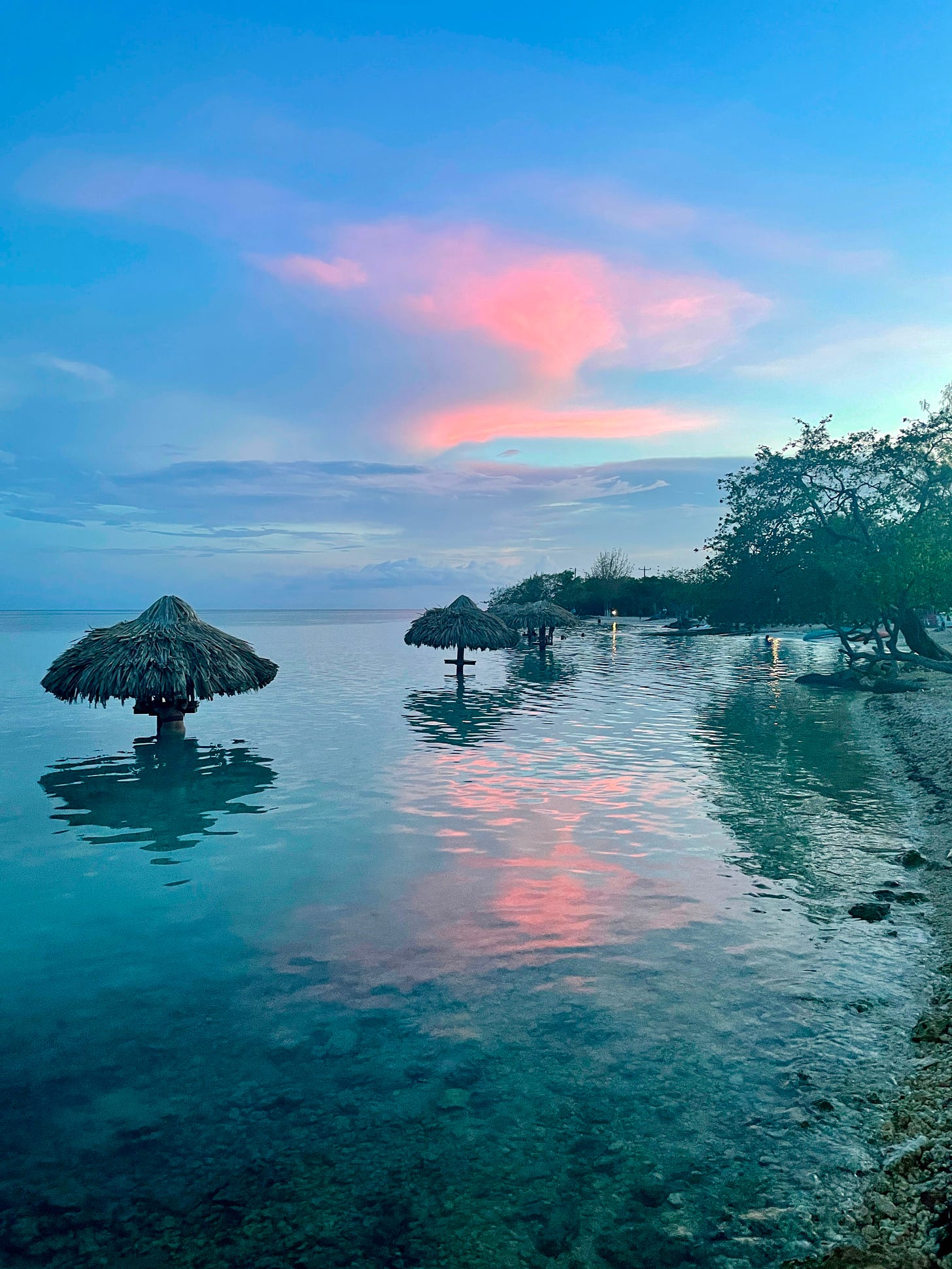Holiday Shopping with a Twist: Picking Coffins and Reflecting on Legacies
Series exploring End-of-Life Arrangements
Heads up, dear reader: In these pages, we're gently navigating through life’s most profound journey - discussing death, funerals, and the legacy we leave behind. While my hope is to create a space for open, vulnerable conversations about these universal experiences, a place where we can talk about death as naturally as we do about life, I recognize these topics can be intense and evoke strong emotions. If these themes feel too heavy right now, feel free to pass on this one. Always remember to prioritize your heart and emotional well-being.
Welcome to a journey that is mine, but also yours, a journey that belongs to everyone—a journey into life's final chapter. For the past two and a half years, I have been readying myself—not just in the small, practical ways, but also in the deep, tender ways: tending to the heart, preparing the spirit. In the days ahead, I hope to share with you what it means to prepare for the great unknown, to shape the end of life with care and intention, to decide what will happen to this body of mine, to the things I've gathered, to the bonds I've built, and how to nurture the spirit for what lies beyond. Picture this as a sonata with four movements—body, belongings, bonds, and soul—each playing its own distinct tune in the grand symphony of life and death.
Before we enter into the matter of the body, let us remember what it truly is. These bodies—temporary vessels for the spirit—are our passage to the world's beauty and sorrow, to every particular, tangible moment that shapes our days. A funeral is more than a farewell; it is a tribute to the delicate, mysterious dance between the physical and the eternal, an honoring of all that this life allowed us to feel, to hold, to witness.
This body is not me; I am not caught in this body, I am life without boundaries. Thich Nhat Hanh
First Movement: My Body. All I want for Christmas is….a coffin?
As 2023 drew to a close, the holiday season served up a peculiar blend of reflection and pragmatism. Adrian’s visit to New York City, just before we headed off to Asia, kicked off a holiday escapade that was anything but traditional: we embarked on a tour of funeral homes, diving deep into the particulars of post-mortem arrangements.
This rather unconventional journey actually began shortly after my diagnosis. I created a collaborative online document, a living, breathing repository where those dear to me could weigh in on these delicate matters. What started as a practical checklist transformed into an ongoing testament to my evolving wishes—covering everything from end-of-life care to my last days, relationships, belongings, and the inevitable question of what to do with whatever is left of me.
The Environmental Toll of Traditional Burials and the Rise of Greener Farewells
In my exploration of post-mortem options, I stumbled upon some jaw-dropping figures: annually, burials in the U.S. consume around 4.3 million gallons of embalming fluid, swallow 20 million feet of wood, and require a staggering 1.6 million tons of concrete—not to mention 64,500 tons of steel, according to the Green Burial Council International. It makes you wonder if, even in death, we might embrace a touch more humility.
I knew traditional burial methods weren’t exactly kind to the environment, but the actual numbers were a true eye-opener. Discovering how embalming fluids contaminate soil and groundwater, while also posing serious health risks to funeral workers, added another layer to the picture. Then there's the unsettling impact of climate change, exposing graves that were meant to rest undisturbed. These revelations only strengthened my resolve against embalming and confirmed my commitment to more eco-friendly practices.
I first looked into aquamation, also called water cremation or alkaline hydrolysis. What stands out about this process is its energy efficiency—it uses 90 percent less energy compared to traditional cremation. It also avoids direct pollutants and doesn’t rely on fossil fuels. Desmond Tutu’s decision to choose aquamation for his state funeral further underscores its growing appeal. Regrettably, aquamation is not yet available in New York or neighboring states. The closest facility offering this service is in North Carolina, but transporting a body across state lines can be complex and often necessitates embalming.
I also explored human composting (natural organic reduction), green burials, and the variety of sustainable, biodegradable coffins and urns now available. From Etsy artisans to online casket companies—one of which has actor David Dastmalchian as its ambassador—the options are expanding, offering a more earth-conscious approach to our final rest.
Green burials are gaining traction as a compelling alternative to traditional burial practices. Technically, they are the most environmentally friendly option for the disposition of remains. By using biodegradable materials and avoiding chemicals, green burials minimize ecological harm while allowing the body to decompose naturally, ultimately enriching the ecosystem.
It's a bit disheartening to see how few options there are for green burials in the New York City area, especially when contrasted with the strides in eco-friendly practices seen elsewhere, particularly on the West Coast. Limited space, high costs, logistical hurdles, and the urgency for prompt burials have all conspired to make this the case. But there's a certain comfort in not being anchored to one spot for my final resting place, especially given a life spent largely on the move. I'm leaning toward cremation, which offers my loved ones and me the freedom to craft a farewell that genuinely reflects our values and preferences.
I'm also exploring the possibility of donating post-mortem tissue for cancer research at Memorial Sloan Kettering, through their Last Wish program. There’s no cure yet for my rare cancer, cholangiocarcinoma, and biopsies are often challenging, especially with inoperable tumors like mine. My body could be a source of answers, if it could help researchers inch closer to a breakthrough—if it could offer even a glimpse of hope for someone else—that feels like another legacy worth leaving. (After death, they take the body for 24 hours and then return it to the funeral home of your choice).
What you leave behind is not what is engraved in stone monuments, but what is woven into the lives of others. - Pericles
For a bit of levity in our otherwise weighty explorations, I've occasionally entertained my loved ones with some less-than-conventional ideas for my remains. Among them: space burial to orbit the Earth forever; a firework dispersal to 'go out with a bang'; a reef ball interment to nurture marine life; sea burials for a whimsical 'sleeping with the fishes'; transforming my ashes into memorial diamonds to sparkle eternally; and pressing my remains into a vinyl record for my ultimate 'Greatest Hits'. If none of these appeal, there's always the $67,000 Utah pyramid mummification—like buying a luxury car, but with a deluxe ride to the afterlife. And the list goes on. Reflecting on these offbeat choices, I'm reminded that my journey has already been filled with enough adventure—no need for extraordinary final gestures to add to the mix.
E-Foiling Into the Beyond: Embracing the Sunset of Life, Fiji, October 2023.
Meeting Funeral Directors
The holidays seemed like the right moment to begin conversations with local funeral homes—an opportunity to consider who could best guide my loved ones through the logistics and, more importantly, provide the support they’ll need to navigate the emotional terrain of my death. This includes helping them address the anticipatory grief they're already experiencing—an often overlooked yet crucial part of the mourning process, which can actually help ease the eventual loss by allowing time to prepare emotionally and find some sense of closure.
Raised in a society where funeral homes evoke discomfort, if not outright dread—even with pop culture gems like Six Feet Under and Alison Bechdel's Fun Home softening the stigma—I was pleasantly surprised by just how profound and illuminating our conversations were. Adrian and I found the interactions to be deeply insightful, often even lighthearted, expanding our understanding of death as an intrinsic part of the human journey rather than something to be feared or shunned.
Our visit to a particularly forward-thinking, modern funeral home in Brooklyn was an unexpectedly eye-opening experience. This place stood out not just for its bright, stylish, and contemporary design—which created a warm and inviting atmosphere—but also for its commitment to the growing trend of "end-of-life wellness" (a gentler rebranding of "death positivity"). It was a refreshing departure from the predominantly traditional, somber-looking funeral homes, replacing the usual gloom with a sense of genuine care and optimism for this inevitable chapter of life.
This funeral home differentiates itself from traditional funeral services with its unique approach. It is exceptionally attentive to the individual needs of its clients, providing adaptability, innovation, and transparency. The establishment excels in arranging 'exit parties' or ‘living funerals’ for those with terminal illnesses and orchestrates Death Doula events, Grief Groups, Grief Walks, and even hosts a book club centered on themes of death, mortality, and bereavement.
Throughout our afternoon visit, we were captivated by the director's charisma, whose blend of empathy, humor, and engaging storytelling gave us a comprehensive understanding of the extensive options and support available.
In a touching instance, the Director recounted to us how he organized a funeral for a 19-year-old university student who had passed away tragically. The student's parents wanted a ceremony that reflected her love for botany and deep bond with nature. To achieve this, the director converted the funeral space into a lush, tropical rainforest, complete with a range of real trees, benches, and floor pillows, creating an immersive atmosphere. The coffin, a canoe adorned with handwoven English fabric, was a touching personal tribute.
The narrative took an intricate turn as he discussed the family dynamics surrounding the girl's remains. A disagreement arose between her parents over how to handle her ashes. Acting as a mediator, the Director provided a temporary solution, housing the ashes at the funeral home as a sort of liminal space while awaiting a resolution. Yet in an unforeseen turn of events, as the girl's birthday approached, her father requested to take the ashes for 24 hours. Instead of returning them at the appointed him, he had hopped a plane to his home country of India, to the Ganges river. In a haze of psychedelics, a journey both within and without, he scattered half of her ashes in its sacred waters.
.This act, seemingly born from a chaotic dance of grief and transcendence, wove its own strange magic. The mother, previously at odds with the father, found in her heart a space for acceptance, a closure that embraced the remaining ashes. This poignant episode highlighted a profound truth: in the labyrinth of loss, where conventional paths offer no solace, peace and acceptance can emerge from the most unexpected quarters.
The Director then delved into the life and final chapter of a 59-year-old schoolteacher, whose journey had suddenly concluded in the grips of pancreatic cancer, leaving a profound void in the lives of her five children. Known for her strong aversion to flowers but fervent passion for lemons, the Director eschewed conventional floral offerings to create a breathtaking orchard of towering 15-foot lemon trees. In this lush, green sanctuary attendees were invited to pick a lemon from one of the trees, a symbol of her warm, nurturing spirit, and later to plant the seeds, an act symbolizing the unending cycle of life and death. It was touching to see how in this verdant oasis, guests were gently guided by her love for lemons, a passion that, in its uniqueness, illuminated the path to celebrating her life and legacy.
In an equally memorable account, the funeral home responded to a daughter's wish to avoid a traditional coffin for her mother. They fashioned a tranquil space by draping a table with luxurious pillows covered in exquisite fabrics from Madrid. The arrangement of these pillows, complemented by elegant canvases used as linens and drapes, lent the area a calm, sanctified ambiance. The space was further transformed with cherry blossom trees and the gentle glow of a thousand candles. The atmosphere was further enriched by the rhythmic beats of Yoruba drums and their accompanying chants. In this serene ceremony, attendees gathered on the floor for an all-night vigil, paying tribute to the departed in a uniquely soulful manner.
If you're wondering about the veracity of these accounts, rest assured, I am not embellishing. The Funeral Director's attention to detail, empathy, and compassion in his interactions with each set of loved ones was truly remarkable. He shared these narratives with the wisdom and insight of someone deeply attuned to the shadowy thresholds of life and death, offering us a glimpse into his profound understanding of these universal experiences.
Another poignant story involved a man wrestling with the quandary of handling his loved one's ashes. His question was straightforward: "What do I do with this vessel? How do I open it?" The guidance he received was simple: "Break it.” When the man shattered the vessel, he described being overwhelmed by an intense wave of emotion which broke down the barriers of his fear. This act of breaking the urn brought about a profound release, enabling him to feel his grief. He later reflected that this singular moment set him on a path towards deep healing.
Amid the backdrop of the COVID pandemic, one family resisted the impersonal nature of an online funeral, seeking a more meaningful way to say goodbye. They envisioned a documentary — a venture to encapsulate the essence of the deceased through the lens of those who knew her intimately. So the funeral director, along with a film crew (and adhering to all safety protocols), embarked on a worldwide journey. Transformed into a chronicler of memory, he engaged in heartfelt dialogues in the homes of the deceased's closest companions. Over three months, these emotionally charged and candid conversations were woven into a film — a rich mosaic of tales and tributes that served as a testament to the profound impact of a life fully lived.
Another globe-trotter opted for a unique way to handle her ashes. She requested they be placed in tiny bottles to be distributed to those present at her funeral. Attendees were invited to scatter her ashes all over the world during their own travels, symbolizing her adventurous spirit and love for exploration.
In a narrative punctuated with gravitas, the funeral director counseled us on the paramount importance of articulating one's final desires with crystal clarity. He said that every nuance should be communicated clearly to the next of kin — whether to be draped in a red shroud, have a toast raised with bourbon or champagne, or to completely eschew any traditional funeral rites. He underscored the need for detailed instructions, encompassing everything from location to timing as well as the preferred simplicity or intricacy of the ceremony. Such meticulous planning, he offered, was not only key to ensuring that last wishes are honored but that it would forestal room for misunderstanding or familial disputes.
Our discussion with the director was a profoundly enlightening experience for both Adrian and me. We appreciated his candidness and warmth and were touched by his deeply compassionate approach. His insights illuminated the vast range of options available in the modern funeral industry. Each visit, story, and innovative concept broadened our understanding and heightened our appreciation for the varied ways people can say goodbye, honoring the uniqueness of each life in a personal tribute that aligns with their spirit and values.
It gave us a lot to reflect on. I’ve realized I favor simplicity over extravagance—no need for my ashes to take distant journeys, no large-scale environmental alterations, no grand spectacles. While I understand and respect the profound meanings others find in such acts, my heart leans toward a different kind of legacy — part of which is embodied in a fund bearing my name, supporting those who tirelessly fight for justice on the front lines of conflict and post-conflict regions. This choice feels like a true reflection of the values that have guided me throughout my life.
The true meaning of life is to plant trees, under whose shade you do not expect to sit. Nelson Henderson.
Our meeting with another funeral director later that week was just as profound. She, an elder respected in her field, brought to her work a remarkable depth of spiritual insight and wisdom. Adrian and I were particularly moved by a Tibetan Buddhist ceremony she arranged in Brooklyn. Monks from across the globe, dressed in saffron robes, gathered for ritual prayers and ceremonies. In the home's kitchen, they prepared traditional dishes—chickpea curry and butter tea—and served them to everyone in attendance. After an astrological assessment that took into account the deceased's meditative state at death, their location, and their place in the bardos, it was decided that the body should remain at home for 48 hours, and the funeral procession would begin precisely at 6:58 a.m.
When the time came, the procession moved solemnly from the home to the crematory. The deceased, a devout Buddhist practitioner, had undertaken prolonged fasting before his death. The director pointed out the unique nature of his transition: the body, nearly mummified, showed no signs of decay. The entire experience resonated deeply, embodying a fundamental aspect of Buddhist funeral traditions—the reverence for the deceased and the care taken to guide their spiritual journey onward.
This experience, alongside countless others, has deepened my appreciation for how different cultures embrace the inevitability of death. Every tradition, every custom adds another tile to the mosaic of human experience—each revealing something about how we seek meaning at the edge of the mystery. If you’re as curious about these variations as I am, there’s a book I’d recommend that beautifully explores this vast tapestry.
As I reflect on these experiences, I find myself still turning over the particulars of my own departure. I’ve completed the advanced planning documents, though a few decisions linger—including those concerning my final moments alive. The process is ongoing, evolving with each fresh insight and each new conversation. For now, I take solace in knowing we’ve begun the important discussions and laid the foundation. The rest, I trust, will fall into place, shaped by the values that have always mattered most to me.
For those looking to delve further, I've included some reflection questions below. 😉
For life and death are one, even as the river and the sea are one.– Khalil Gibran
REFLECTION QUESTIONS
How can your unique life story, values, and beliefs shape your end-of-life arrangements? What symbols, rituals, or traditions hold deep meaning for you, and how might these be thoughtfully incorporated into your final farewell to ensure it resonates with your spirit?
What kind of setting would be ideal for discussing your end-of-life wishes with loved ones? How can you create a space that encourages open and meaningful conversations?
Beyond practical planning, how can end-of-life discussions serve as an avenue to express love, share memories, and strengthen relationships? Have you considered leaving behind a letter, a video message, or another personal token that your loved ones can cherish?
What legacy do you wish to leave behind? Beyond material assets, if any, what emotional, social, and ethical impact do you want to make on the lives you touch and the communities to which you belong?
How can we recognize the privilege of planning a peaceful departure in a safe environment? How might you extend support to those in conflict-ridden areas, facing uncertainty and distress at the end of life?
“The trouble is, you think you have time.” Buddha
Please stay tuned for upcoming posts:
Second Movement: Medical Decisions & Personal Belongings - A look into the important medical and care choices to be made at end of life. This post will also touch upon the emotional journey and practicalities involved in handling personal belongings.
Third Movement: Guiding My Son and Preparing My Soul for the Journey Ahead -An intimate exploration of the wisdom and guidance I hope to leave behind, paired with thoughts on spiritual and emotional preparation for what lies beyond. (this piece has now been posted:
When it's over, I want to say all my life
I was a bride married to amazement.
I was the bridegroom, taking the world into my arms.
When it's over, I don't want to wonder
if I have made of my life something particular, and real.
I don't want to find myself sighing and frightened,
or full of argument.
I don't want to end up simply having visited this world.Mary Oliver, from “When Death Comes”
See here for full poem









another beautifully overwhelmingg written piece--eagerly await next chapter
selma
So resonant. I was just at the Meiji Shinto shrine, praying that Chris & I - most importantly Chris - will find peace in his final days. Just as I was about to cross the gate to leave the grounds, there was an earthquake. Light & energy hugs to you!